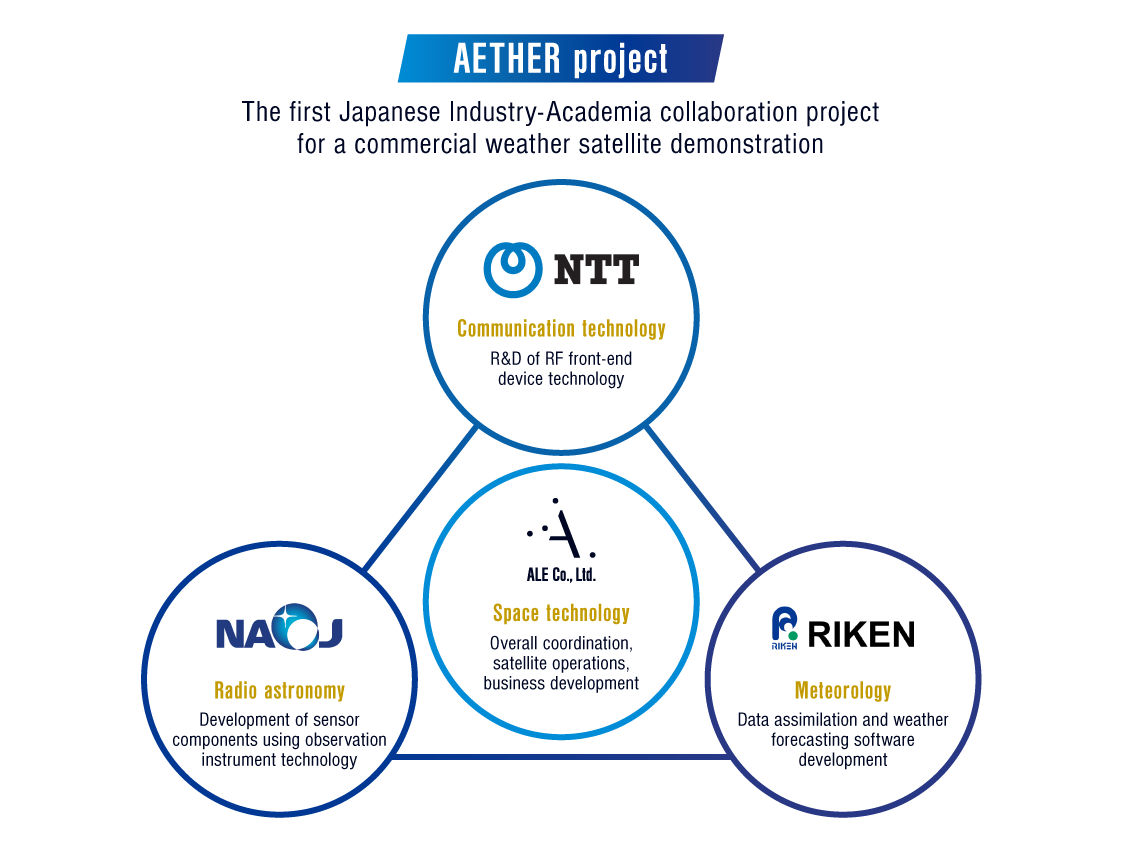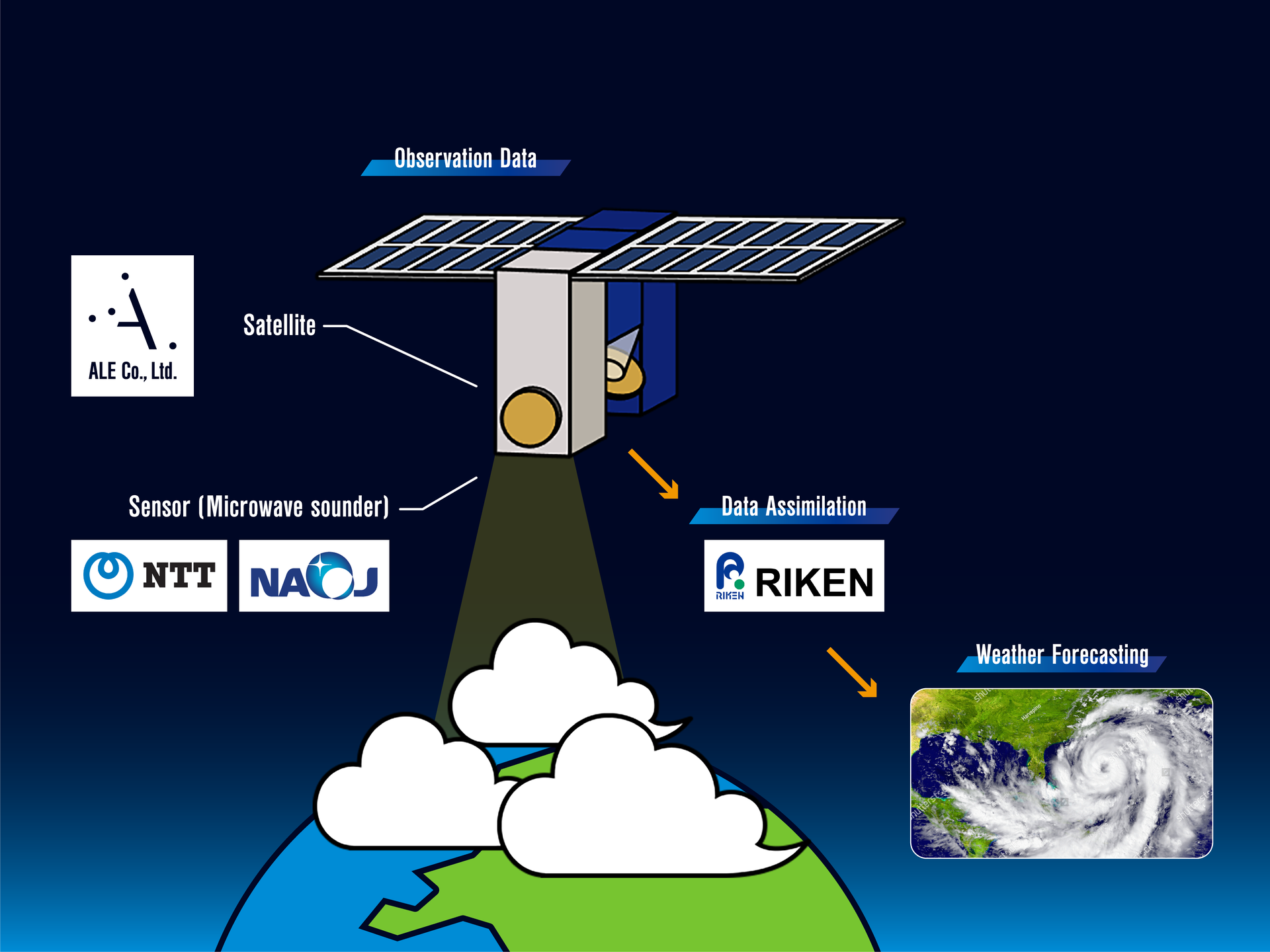Tokyo-based ALE Co., Ltd.(ALE), led by CEO Lena Okajima, with the mission to make space closer for people, signed a memorandum of understanding (MOU) and joint research agreements on the development of weather satellites with NTT Device Technology Laboratories, NTT Corporation (NTT), RIKEN Center for Computational Science, and National Astronomical Observatory of Japan (NAOJ) on 27th September 2021, launched AETHER, an Industry-Academia collaboration project to tackle natural disasters with commercial weather satellites.

In recent years, the severity of natural disasters has been increasing around the world. In particular, the impact of disasters related to climate change is significant, with economic losses amounting to US $2,245 billion (77% of all natural disasters) over the past 20 years. Due to geographic factors, Asia is more susceptible to natural disasters, and Japan, completely surrounded by water, is one of the most affected countries (*1). To cope with these geographical conditions, we have launched the Industry-Academia collaboration project, AETHER, we thrive to reduce unreasonable damage from disasters by utilizing space. By developing an original small sensor for Earth observation and acquiring atmospheric data from space with a weather satellite equipped with it, we can improve the accuracy of weather forecasts based on this data. These satellites were developed by bringing together the participating organizations and utilizing their expertise in their respective fields to ultimately provide weather information suitable for the current global environment to the world from Japan, a country prone to disasters. AETHER will be the first Japanese project to acquire observation data for weather forecasting with a commercial weather satellite.
■Background and features
Ideally, weather forecasting should be based on a wide range of stable observations regardless of location or time. Having said that, observation data taken from above the sea is not sufficient as the observation methods are limited compared to those acquired from land. In the case of island nations like Japan, acquiring a wide range of data including from above the ocean is paramount for weather forecasting in coastal regions. Satellites are suitable for continuous observation of a wide area under such conditions, and until now, large government satellites have played this role and contributed to weather forecasting.
However, large satellites are very expensive to manufacture and to operate, and it is not easy for the government to continue to operate them with a limited national budget. On the other hand, weather forecasting is becoming more and more important due to the increasing number of natural disasters. For example, heavy rains and typhoons are phenomena for which it is important to have atmospheric data several hours to multiple days ahead of them occurring, which is a relatively short period of time for weather forecasting. In order to improve the forecasting of these phenomena, more frequent and detailed data is required. Thus, more frequent and detailed data will demand the improvement of technology and the enhancement of related infrastructure.
AETHER will use CubeSat(*2), which is becoming a common use, to drastically reduce the cost (from hundreds of millions of dollars to millions of dollars per satellite, or from billions of dollars to tens of millions of dollars per project, a reduction of about 1/100). In addition, we will develop a "microwave sounder" for CubeSat as a sensor to observe water vapor and temperature, important factors for weather forecasting, in the atmosphere day and night regardless of weather conditions, one of the most important factors for weather forecasting. With this additional data, we will be able to contribute to disaster prevention and mitigation as part of the commercial sector. Providing more frequent and additional observational data, we can complement the government's large satellites by creating a “satellite constellation”, an assembly of multiple satellites and their operation technologies.
■The role of each participating organization
Weather forecasting is done by observational data which shows the present, weather model which can simulate the future, and data assimilation which combines the observational data and weather model to help improve the accuracy of weather forecasts (*3). In AETHER, organizations specialized in each field have come together and established an integrated research and development system, ranging from observation to forecasting.
NTT and NAOJ are in charge of the research and development of the core components of the small microwave sounder (*4), using sub-millimeter wave-band device technology in communication field and receiver technologies used for observation instruments in radio astronomy, respectively.
RIKEN will develop software for data assimilation and weather forecasting using its meteorological knowledge of large computer systems such as the supercomputer "Fugaku".
ALE will be in charge of the overall coordination of hardware and satellite operations using space technology cultivated in other projects and will also oversee the business aspects of AETHER in order to connect the technologies and knowledge of each organization to the new meteorological business.
■Future Plans
The first step will be to develop elemental technologies, followed by a ground demonstration using a prototype, with the goal of a space demonstration within five years. Eventually, we plan to provide weather-related services from observation data to solution services based on weather forecasts.
■Origin of the project name AETHER
The name AETHER comes from the Greek god who deified the clear air that the gods breathe in the sky, and this name represents the glow of the sky that never disappears. Nature can sometimes threaten humanity with disasters. By understanding the phenomenon behind these natural disasters, we can learn how to cope with them and take actions.
The name "AETHER" expresses our hope that our activities through science and space will help to reduce unreasonableness and increase happiness in the current global environment.
■Comments from each participating organization
◆Comment from Akira Okada, Vice President, Head of NTT Device Technology Laboratories
NTT has been conducting research and development of InP-based transistor technology with superior high-speed performance, and has been contributing mainly to the advancement of communication systems. I am very grateful that the device technology we have developed has given us this opportunity to contribute to the new field of social safety and security, such as disaster prevention and weather forecasting.
◆Comment from Takemasa Miyoshi, Team Leader, RIKEN Center for Computational Science
I have been leading advanced research using the top-class supercomputers " K " and " Fugaku " to revolutionize weather forecasting by utilizing new satellite data. I would like to connect this world-leading top science to the development of AETHER's sensors and weather forecasting systems, and contribute to the success of Japan's commercial weather satellite business and the reduction of inexcusable disaster damage.
◆Comment from Yoshinori Uzawa, the director of Advanced Technology Center, National Astronomical Observatory of Japan
We have contributed to the advancement of astronomy by developing highly sensitive radio receivers and installing them on the Nobeyama 45-meter telescope and the Atacama Large Millimeter/submillimeter Array (ALMA)in Chile. In addition, we have just established the Industry Liaison Office in order to utilize the technology for astronomy we have developed as technology that supports our daily lives for the benefit of society. I am very happy that our technology is expected to contribute to weather forecasting, which is indispensable for building a safe and secure society, and at the same time, I feel the weight of the role we need to fulfill.
◆Comment from Lena Okajima, CEO, ALE Co., Ltd.
For us at ALE, who have been aiming to connect science and society with the mission to make space closer for people since our establishment, it is a very emotional moment to tell you about the launch of this project. We are delighted to be able to work with such a great group of people on this AETHER project, which will help to solve social issues through scientific knowledge, with the aim of elucidating climate change and extreme weather events and using weather forecasting to prevent disasters.
*1) Source: "Economic losses, poverty & disasters: 1998-2017", University of Louvain (Belgium), Centre for Research on Disaster Epidemiology/United Nations Disaster Reduction Agency.
*2) CubeSat: A common standard for satellites with a basic unit size of 10 x 10 x 10 cm (weighing about 1.3 kg). The size is indicated by "X "U, where "X" indicates the number of basic units.
*3) "Data assimilation" is the technique to improve the accuracy of forecasts by comparing simulation results based on weather model with actual observation data
*4) Microwave sounder: A passive sensor that receives radio waves in the wavelength region of microwave including (sub-)millimeter wave which have longer wavelengths than visible light and infrared. The detected microwave signal contains information about the atmosphere, such as water vapor and temperature.
■About ALE Co., Ltd.
ALE is a private space start-up company with the mission to "Make space closer. For all of us. Together". ALE aims to provide space entertainment content such as man-made shooting stars to enjoy the beauty and the possibilities of space in order to entice human curiosity and accelerate space development. We also aim to obtain valuable data from space to elucidate the mechanism of global climate change. Furthermore, we will contribute to the maintenance of the on-orbit environment through the development of space debris mitigation devices, and aim for the sustainable development of the space industry. Through these approaches, we will contribute to the sustainable development of science and human society.
Company Name: ALE Co., Ltd.
Address: 2-11-8 Shibadaimon, Minato-ku, Tokyo 105-0012, Japan
CEO: Dr. Lena Okajima
Established: 1st September 2011
Nature of Business: Space entertainment (Sky Canvas), Atmospheric data, Small satellite research and development
URL : https://star-ale.com/en/
■About NTT Corporation (NTT)
Company Name: NTT Corporation (NTT)
Address: Otemachi First Square, East Tower, 5-1, Otemachi 1-Chome,
Chiyoda-ku, Tokyo 100-8116, Japan
CEO: Jun Sawada
Established: 1st May 1985
Nature of Business: Mobile Communications Business, Regional Communitcations Business, Long Distance and International Communications Business Data Communications Business, Other Businesses
URL : https://group.ntt/en/
■About RIKEN
Company Name: RIKEN
Address: 2-1 Hirosawa, Wako, Saitama 351-0198, Japan
President: Hiroshi Matsumoto
Established: 20th March 1917
Nature of Business: Research in the natural sciences (physics, engineering, chemistry, mathematical and information science, computational science, biology, medical science, etc.)
URL : https://www.riken.jp/en/
■About National Astronomical Observatory of Japan
Organization name: Inter-University Research Institute Corporation, National Institutes of Natural Sciences, National Astronomical Observatory of Japan
Address: 2-21-1 Osawa, Mitaka, Tokyo 181-8588, JAPAN
President: Saku Tsuneta
Established: 1st July 1988
Nature of Business: Affairs related to research in astronomy and related fields, observation of astronomical phenomena, compilation of calendar books, determination and publication of Central Standard Time, and verification of clocks (Ordinance of the Ministry of Education, Culture, Sports, Science and Technology No. 57, Enforcement Regulations of the National University Corporation Act, Article 1, Article 5, paragraph (2) of the National University Corporation Act)
URL : https://www.nao.ac.jp/en/